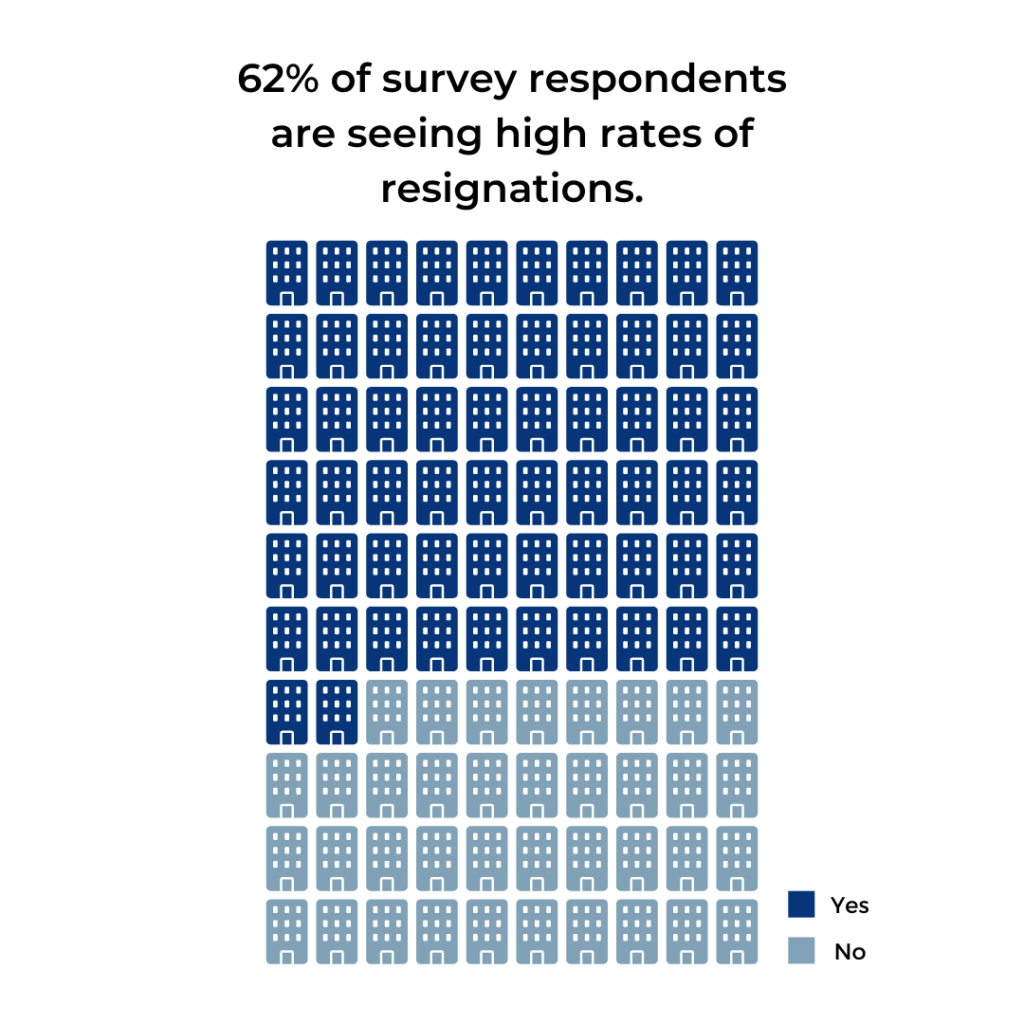Retaining Talent through the Great Resignation
Strategic HR Consulting
The pandemic has created a new normal for many: working from home, juggling work and balancing family priorities. It has also given people a chance to reflect on their life and careers. Many are choosing to quit what they are doing and seek jobs with improved compensation, better work life balance, or to follow a calling or passion.

This phenomenon in employee behaviour is known as the great resignation and is affecting employment rates and companies around the world. The US and UK are seeing record high resignations, and while the trend is not as high here, Canadian companies are also experiencing changes in retention. In a recent People First HR survey, 62% of respondents said their companies are seeing higher resignation rates. In August 2021, Canada’s unemployment rate was the lowest it has been since February 2020, while the job change rate is back up to pre-pandemic levels (Stats Canada).
With more Canadian workers choosing to leave their current jobs for new employment, we are not only seeing a great resignation but a great migration. This leads us to ask, how are businesses and leaders retaining talent through the great resignation?
Through our survey and conversations with knowledge leaders, executives in key Manitoban companies, we have identified three strategies companies are using to retain talent through the great resignation;
- Strong communication
- Engaging and supportive organizational culture
- Career conversations / stay interviews
Strong communication
Communication with employees has always been key to keeping employees engaged and creating a sense of belonging. A Gallup study found that employees are more likely to want to stay with an organization that has open, timely, and accurate communication.
Companies that focused on communications through the pandemic say they have been able to maintain higher retention rates. If your organization has not been communicating enough, it is time to start. While we move into a new normal, organizations will still experience change and need to keep employees informed.
- Share news and be honest with your teams. Keep employees in the loop about change, so they are not surprised.
- Use a variety of channels to reach your employees: virtual town halls, team meetings, emails, in person, etc.
- Get feedback and listen to it. The best communication is two-way. Use surveys and small team discussions to learn how your staff are feeling. Report back to employees on your findings and tell them what you are going to do about it.
Engaging and supportive organizational culture
LifeWorks’ Mental Health Index indicates that managers are experiencing greater mental health issues and more stress than non-managers. When managers and people leaders are not engaged in their work, it can negatively affect their teams, workplace culture, and productivity. This results in resignations of managers and employees.
Some organizations shared that focusing on supporting their people leaders has helped maintain retention rates. Communicating with leaders through change, talking to them about their needs, offering flexibility, and providing tools and training are a few ways to keep your managers engaged and ready to lead their teams.
Additionally, cultivating culture means creating a workplace that people want to be part of. Organizations that have been successful at retaining their employees have engaged in practices like socially distanced get-togethers to create community, inviting staff to run their own workshops for co-workers, like painting or other hobbies and interests. Finally providing flexible working arrangements (hybrid, work from home, flexible work hours) has given employees the ability to make choices that accommodate their circumstances and make it easier to stay.
Career conversations / stay interviews to retain talent
With so much emphasis put on exit interviews, some companies are stemming the flow of resignations with “stay interviews” to discover what it will take to keep employees on their team. Career conversations can be a powerful tool that aligns employee goals with organizational objectives, enhances engagement, and improves retention. For an effective career conversation, managers should follow these five steps:
- Prepare for the conversation
- Communicate the goal of the meeting
- Keep the conversation informal
- Talk about their career path and where the individual wants to go
- Follow up with feedback
It is best to have career conversations before your employee tells you they want to leave. It is important to be ready to address their needs and interests by offering realistic and meaningful changes to help them stay, while considering their long-term career goals.
Moving through the great resignation
While we wish the pandemic was long behind us, the reality is that we will continue to see it affect workplaces for a long time. Our industry executives predict that companies will have to do a better job providing technology and tools while people work from home, create better cultures, and be prepared for continued change. To help retain talent through the great resignation, it is time to focus on your employees and strengthen your internal communication, culture, leadership support, and career conversations. Remember that employees that feel valued and engaged are less likely to leave your organization.
